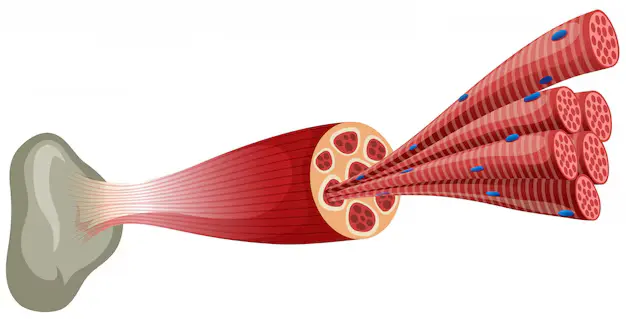
PROMO!
First order? Get 10% OFF with this code: 1storder
Written by

Muscle growth peptides are studied by researchers who want to learn how to increase muscle mass in lab models. The most well-known research peptides for muscle growth include GDF-8 (Myostatin), MK677, and Follistatin.
GDF-8 is researched for its crucial role in slowing down muscle growth. When its effects are blocked in studies, muscle mass often increases.
MK677 is studied because it boosts growth hormone and IGF-1 levels, supporting lean muscle growth and tissue repair in research subjects. Follistatin is researched for its ability to block Myostatin, which may support larger muscles in animal studies.
Peptide Works offers all of these peptides for research only, not for human use. Understanding how these peptides function provides deeper insight into their roles in muscle development and recovery.
Explore GDF-8 from Peptide Works, studied for its role in muscle regulation and how inhibiting natural growth limiters may influence lean muscle mass and connective tissue dynamics in research models.

Muscle growth peptides help muscles grow by sending clear signals in research. GDF-8, also called Myostatin, usually limits muscle size.
Studies show blocking GDF-8 lets muscles grow bigger. MK677 raises growth hormone and IGF-1 levels, which support muscle and bone growth in various research.
Follistatin blocks Myostatin, helping muscles get larger by freeing growth pathways. Each peptide works on different paths that help with muscle repair, protein creation, and size increase seen in research.
With this basic understanding of peptide mechanisms, the specific role of GDF-8 in muscle regulation becomes clear.
Discover MK-677 from Peptide Works, a growth hormone secretagogue researched for supporting muscle gain, fat reduction, and bone density.
GDF-8, also called Myostatin, is a protein that naturally limits how much muscles grow. It sends signals to muscle cells, telling them to stop growing after reaching a certain size.
When Myostatin is blocked in research, muscles grow larger and stronger faster. Studies also show Myostatin affects muscle fiber formation and how quickly muscles recover from damage.
Because of this, many researchers focus on Myostatin to understand muscle growth better and test peptides that can inhibit it for improved muscle development. Blocking Myostatin influences both growth and recovery processes in significant ways.

Blocking Myostatin with certain muscle growth peptides helps muscles grow larger and recover faster in studies. Myostatin limits muscle size by telling muscle cells to stop growing.
When peptides block Myostatin, muscle protein synthesis increases and muscle breakdown slows down. Research shows this causes rapid muscle gains, stronger muscles, and better repair after injury.
Some studies also suggest blocking Myostatin can reduce body fat and improve bone strength.
These muscle growth peptides are important tools in muscle recovery and strength research. Muscle recovery after injury is a critical aspect affected by these peptides.
Muscle growth peptides support recovery by helping repair muscle fibers and increasing protein synthesis after injury. Blocking GDF-8 (Myostatin) allows muscle cells to rebuild faster and grow stronger.
MK677 raises growth hormone, which speeds tissue repair and muscle cell recovery. Follistatin enhances muscle growth by limiting Myostatin’s effects, aiding quicker regeneration.
Studies highlight these peptides’ role in improving muscle repair and strength after damage. These muscle growth peptides are key research tools for understanding healing and muscle growth in scientific studies.
Among these, Follistatin has distinctive features that strengthen its impact on muscle regeneration.

Follistatin is a special muscle growth peptide because it targets both Myostatin and Activin, two proteins that slow down muscle growth.
This wider action lets more muscle cells grow and repair quickly after damage, as shown in research. Follistatin also helps wake up muscle satellite cells, which are needed to build new muscle fibers after injury.
Recent studies show blocking both Myostatin and Activin gives better results in muscle size and quality than just blocking one.
This makes Follistatin a valuable subject for muscle growth research. The role of muscle satellite cells is essential when considering how peptides assist muscle growth.
Checkout Follistatin from Peptide Works, a potent Myostatin and Activin blocker studied for enhancing muscle regeneration and size in research models.
Muscle satellite cells are special stem cells resting next to muscle fibers, quietly waiting until muscle is stressed or injured. When growth signals arrive, like those sent by muscle growth peptides, these cells “wake up,” multiply, and fuse with existing muscle fibers.
This action adds more nuclei, letting each fiber grow bigger and repair itself faster. Peptides such as those targeting Myostatin or boosting growth hormone make satellite cells more active, increasing muscle size and speeding up recovery.
Researchers see satellite cells as key to long-lasting, healthy muscle gains in peptide studies. Researchers are finding faster, more effective ways to harness these peptides for muscle growth and recovery.
Muscle growth peptides are advancing quickly, with new research exploring how to target pathways like satellite cell activation and muscle hypertrophy for even better results in lean muscle mass development.
As science reveals more about these cells and specific peptides, future solutions may deliver faster muscle repair, potential for greater strength gains and potentially safer long-term outcomes through enhanced growth hormone production and improved recovery.
Continued studies and strict quality standards will shape what’s possible, making peptide-assisted muscle growth a leading focus in body composition research for years to come.
All products discussed are supplied for research purposes only and are not intended for human use.
[1] Elkasrawy MN, Hamrick MW. Myostatin (GDF-8) as a key factor linking muscle mass and bone structure. J Musculoskelet Neuronal Interact. 2010 Mar;10(1):56-63.
[2] Hamrick MW, Arounleut P, Kellum E, Cain M, et al. Recombinant myostatin (GDF-8) propeptide enhances the repair and regeneration of both muscle and bone in a model of deep penetrant musculoskeletal injury. J Trauma. 2010 Sep;69(3):579-83.
[3] Lee J, Kwon A, Chae HW, Lee WJ, et al. Effect of the Orally Active Growth Hormone Secretagogue MK-677 on Somatic Growth in Rats. Yonsei Med J. 2018 Dec;59(10):1174-1180.
[4] Kota J, Handy CR, Haidet AM, Montgomery CL, et al. Follistatin gene delivery enhances muscle growth and strength in nonhuman primates. Sci Transl Med. 2009 Nov 11;1(6):6ra15.
[5] Rodino-Klapac LR, Haidet AM, Kota J, Handy C, Kaspar BK, Mendell JR. Inhibition of myostatin with emphasis on follistatin as a therapy for muscle disease. Muscle Nerve. 2009 Mar;39(3):283-96.
ALL CONTENT AND PRODUCT INFORMATION AVAILABLE ON THIS WEBSITE IS FOR EDUCATIONAL PURPOSES ONLY.
DISCLAIMER: These products are intended solely as a research chemical only. This classification allows for their use only for research development and laboratory studies. The information available on our Peptide Works website: https://peptide-works.com/ is provided for educational purposes only. These products are not for human or animal use or consumption in any manner. Handling of these products should be limited to suitably qualified professionals. They are not to be classified as a drug, food, cosmetic, or medicinal product and must not be mislabelled or used as such.
Peptide Works
Related Articles

Best Peptides for Women in Perimenopause: From Libido to Energy
Do you feel drained, struggle with focus, or notice your drive slipping during perimenopause? These changes are some of the

PT-141 for Women in Perimenopause: A Breakthrough for Low Libido
Perimenopause can bring more than just physical changes it often affects how women feel about intimacy, confidence, and connection. Many

Can Vitamin B12 Immune System Support Enhance the Effects of Thymosin Alpha-1?
The Vitamin B12 immune system link is important because this vitamin plays a crucial role in DNA synthesis, methylation, energy